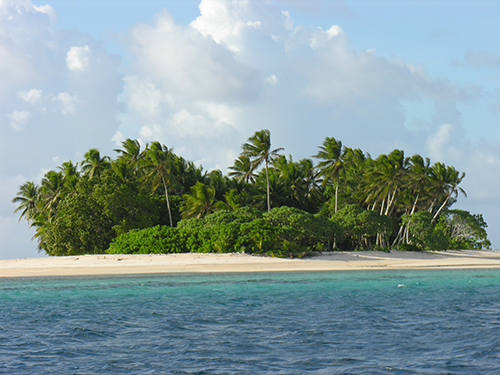 The assistant tells me Newton’s waiting in the van and we must leave now—Newton’s found another storyteller. Majuro is so small, a quarter mile wide and thirty miles long—actually several small islands strung together—you’d think it’d be easy to find the man or woman you’re looking for. But it hasn’t been easy. Life is so fluid here—seven degrees north of the equator in this tiny Pacific nation, just forty thousand souls scattered over seven hundred and fifty thousand square miles of ocean—people come and go with the tide, it seems. From the driver’s seat, Newton waves his greeting. He’s a handsome man of medium height and broad girth, curly graying hair, a slightly graying mustache, and dark brown complexion. Newton and I are trying to preserve this nation’s stories and tales. Until the missionaries found them in the nineteenth century, the Marshallese had lived for three millennia as an oral culture; everything they knew was contained in tales and songs and chants. The value of our project—the Marshall Islands Story Project—is that we are recording the last of the culture’s oral tradition, showing how it has changed, or how it looks and sounds in its last permutation.
The assistant tells me Newton’s waiting in the van and we must leave now—Newton’s found another storyteller. Majuro is so small, a quarter mile wide and thirty miles long—actually several small islands strung together—you’d think it’d be easy to find the man or woman you’re looking for. But it hasn’t been easy. Life is so fluid here—seven degrees north of the equator in this tiny Pacific nation, just forty thousand souls scattered over seven hundred and fifty thousand square miles of ocean—people come and go with the tide, it seems. From the driver’s seat, Newton waves his greeting. He’s a handsome man of medium height and broad girth, curly graying hair, a slightly graying mustache, and dark brown complexion. Newton and I are trying to preserve this nation’s stories and tales. Until the missionaries found them in the nineteenth century, the Marshallese had lived for three millennia as an oral culture; everything they knew was contained in tales and songs and chants. The value of our project—the Marshall Islands Story Project—is that we are recording the last of the culture’s oral tradition, showing how it has changed, or how it looks and sounds in its last permutation.

The palm tree island is a decorative little island that you can use to create a nice tropical effect.
The palm tree island is decorated with two palm trees, trunks and grasses.
The palm tree island looks great in open water, close to the beach, in combination with grassland and even on the mainland.
The footprint of the palm tree island is 10x10 meters
Please visit our store, to see the Palm Tree Island inworld.
 Newton hates driving. When people see him driving me around, they may get the wrong idea. He’s no chauffeur, he jokes. But he drives nonetheless because he knows where we’re going and we’re often going at odd times or without notice, when a driver can’t be found. I call “Iawke!” (literally, “love to you”), then slide onto the van’s shredded front seat. Newton’s assistant hops in the back. Newton recruits assistants either from the junior college or from his neighborhood. Unemployment is over thirty percent here, so help is easy to come by. It doesn’t matter that Newton can’t afford to pay them. He’ll compensate them some other way, sharing food or whatever there is to share. Island tradition has always centered on sharing. If you caught more fish than you could eat, you gave away the rest.
Newton hates driving. When people see him driving me around, they may get the wrong idea. He’s no chauffeur, he jokes. But he drives nonetheless because he knows where we’re going and we’re often going at odd times or without notice, when a driver can’t be found. I call “Iawke!” (literally, “love to you”), then slide onto the van’s shredded front seat. Newton’s assistant hops in the back. Newton recruits assistants either from the junior college or from his neighborhood. Unemployment is over thirty percent here, so help is easy to come by. It doesn’t matter that Newton can’t afford to pay them. He’ll compensate them some other way, sharing food or whatever there is to share. Island tradition has always centered on sharing. If you caught more fish than you could eat, you gave away the rest.

It’s not like you could save anything in this climate. Every van Newton borrows is rusted beyond hope; doors won’t open or shut right; windows won’t roll one way or the other; wipers and rearview mirrors are missing. Don’t even ask about radio or air conditioning. Nothing lasts out here. It’s the most corrosive environment in the world. Rain every day, ninety-percent humidity, voracious heat, windborne sand, and biting salt air. The bike I bought new when I arrived four months ago now looks ten years old. I can’t help thinking how futile it is trying to preserve anything in this place. This rapid erosion brings home the urgency of our preservation project